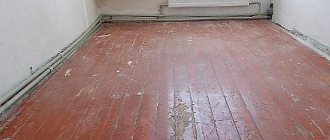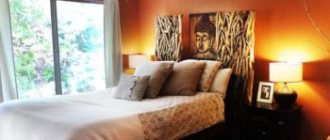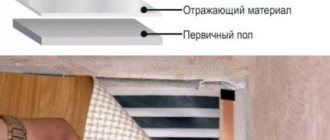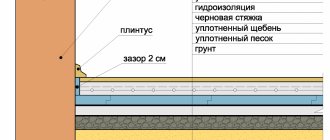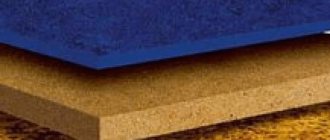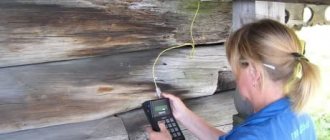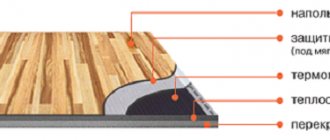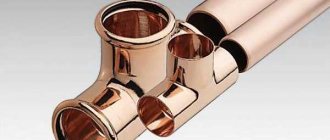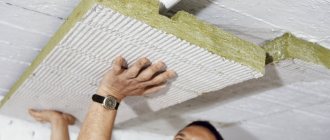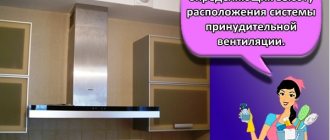Type and property
Adding foil to an existing variety of substrates changes their functional properties and provides a guarantee for a longer period of use. The most important difference is that foil has the ability to preserve heat rays in an apartment or house up to 40%, and with a foil stopper - up to almost 100%.
The backing for linoleum can be made from the following materials:
- polyethylene;
- polystyrene;
- traffic jams.
Polyethylene, the material from which the backing is made, seems to be one of the most common in the entire public market. In order to improve its functional characteristics, production began to make a model in which one side is sealed with foil. In stores and markets, foil polyethylene is produced in the following brands: Penofol, Isolon and, in rare cases, Ecofol. Foaming of this material is carried out in two ways: chemical and physical. It all depends on the quality of production and pricing policy. In order to obtain foamed polyethylene using a chemical method, flame retardants must be added to it. As a result of chemical exposure, pores appear in polyethylene, in which there is gas isolated far from each other. This type of polyethylene copes well with the noise of neighboring apartments; it has the property of vapor permeability and thermal insulation. There is a very big disadvantage - very poor strength, so the foil quickly falls under the linoleum. The function of polyethylene together with foil adds to the service life of the material, plus it adds waterproofing properties, qualitatively increases the efficiency and strength of thermal protection with the help of its reflection characteristic of foil. Can withstand temperatures from 30 degrees cold to 80 degrees hot.
The foaming function is carried out physically in ovens designed specifically for this purpose. This type of molecular bond is of higher quality, which is reflected in the performance properties of the material - at the same time, it does not shrink so quickly. But its price is also much higher. It is produced in a roll of 50 sq.m., has a thickness from 2 to 10 mm, there is also 4 mm, but it is intended for insulating walls or ceilings.
Polystyrene - this material is glued together with foil and foam - foamed using high temperature. It is produced in the form of a plate and has: sound insulation, impact strength, compressive strength, low thermal conductivity. If you add foil, the functionality and waterproofing will improve, which is very important for apartments or houses where there is very high moisture, or there is a risk of floors flooding with water. The pricing policy for such material is high.
Cork – a substrate made of this material has a very large number of advantages:
- durability;
- strength;
- eco-logical;
- acts as an excellent insulation material.
There are also several disadvantages:
- when laying, the room should be dry, without the slightest moisture;
- requires mandatory waterproofing.
Penofol for linoleum: types, installation, properties
Penofol under linoleum is an effective thermal insulation of the floor. The technology promotes hydro-, sound- and vapor barrier of a wooden covering or monolith. If you want to use this method to insulate a house, apartment or shopping center, just familiarize yourself with its types and characteristics.
Laying penofol under warm linoleum
Installation
Penofol is placed under the finished floor. Laying penofol under linoleum is carried out using the “layer cake” system. The insulation is spread with foil inside the room, fixed with a stapler and the joints are leveled. The seams are taped with aluminum mounting tape.
Planks 1.5 - 2 cm thick are installed to create an air gap in front of the foil. As an experiment, you can layer penoplex on top for rigidity, and linoleum.
A loggia or balcony can turn into an additional room with a warm and dry floor. The main thing is to take care of the heat source. The thinness of the material and reflective ability make it indispensable in places where every centimeter is important.
If the surface is made of wood and the house is built on a shallow foundation, the boards need to be puttied and painted. Then the floor surface is covered with penofol and linoleum, carpet or laminate is laid on top of it.
Attention!
Penofol is not recommended for use in a heated floor system.
Underlay for laminate, linoleum
Types of penofol
- Penofol A. Includes polyethylene foam with one-sided foil coating.
- Penofol V. Has double-sided foil protection and is suitable for installing floors on the first floors of buildings with damp basements.
- Penofol C. Foil insulation with self-adhesive tape for reliable fixation to coatings.
Types of linoleum
- Household class (21-23) - a budget option for decorating the floor in a country house or veranda. “Home” linoleum in combination with class A penofol will provide inexpensive insulation of coatings in places where low traffic is expected.
- Semi-commercial class (31-34) is ideally combined with class B penofol. They will delight their owner with an affordable price and the quality of the “warm floor”. Used in office premises, hospitals and educational institutions where medium loads are required.
- Commercial class (41-43) is the right solution for owners of premises with a large flow of visitors. Commercial laying of linoleum on top of Penofol type B or C will provide a representative appearance to the room for a long time.
“Layered cake” made of penofol and linoleum
Advantages
- Environmental friendliness;
- Flexibility, lightness;
- Increased thermal insulation;
- Hydro-, steam- and sound insulation;
- Reducing the cost of heating or cooling a room.
Flaws
The foil surface is a conductor of electricity, which requires additional insulation of the floor.
Pros and cons of foil backing
The advantages are:
- Durability.
- Soundproofing.
- Also thermal insulation.
- Excellent fight against mold and insects.
- The substrate has the property of reflecting heat into the room.
The disadvantage of a polyethylene substrate is that it is not a large development resource, and its high price. But this is one of the substrates that is of high quality. Having the latest properties, a foil backing is indispensable when restoring or installing a heated floor and installing linoleum in a room with high humidity, for example in a kitchen, bathroom or toilet. It is best to use it in dry and well-ventilated areas.
Material selection
First of all, it should be understood that there are no bad or good insulation materials. Each of the materials was developed for certain conditions and these conditions must be taken into account when choosing.
Briefly about linoleum itself
The enduring popularity of linoleum rests on three pillars: an affordable price, high performance characteristics and, of course, a luxurious appearance. Although I would also add simple, uncomplicated installation to this list.
Homogeneous and heterogeneous linoleum.
As a rule, the basis of this floor covering is elastic polyvinyl chloride (PVC). All linoleum is divided into homogeneous, in other words, single-layer, its thickness does not exceed 2 mm, and heterogeneous or multi-level material, here the thickness of the PVC sheet can reach up to 7 mm.
According to its performance characteristics, the coating is divided into household, semi-commercial and commercial. As can be easily understood from the name, the first type is intended for arranging floors in apartments and private houses. The semi-commercial direction is designed for offices, offices, etc. Well, commercial linoleum is the most durable; it is laid in the corridors of public buildings and in the workshops of enterprises.
Material with and without backing.
In this case, we are exclusively interested in the household area, since the floor under such a covering necessarily needs insulation. Although in fairness it should be noted that the insulated linoleum that each of us has probably seen in stores can be installed on a good wooden floor without a backing, but we will talk about this a little later.
What types of insulating substrates are there for linoleum?
All insulation materials that are installed under linoleum are conventionally divided into soft roll-type materials and rigid slab structures . Now let's figure out what is better to cover a wooden base and than a concrete floor.
Advertising often emphasizes the benefits of natural, environmentally friendly materials. So, think before you overpay for such newfangled trends. Linoleum itself is synthetic, and if you “slide” the most natural material under it, the effect and benefits will be comparable to what it would be like if you wrapped flowers in plastic and tried to enjoy their aroma.
- Cork fabric is made from the bark of the cork tree. This material can be selected according to thickness, plus it has several levels of rigidity, which is convenient in our case. But if you decide to lay cork insulation on a concrete floor under linoleum, you will need to take care of waterproofing, since this material does not tolerate moisture well. Cork has the highest level of thermal insulation compared to other soft competitors. But under linoleum you should use the hardest type of coating so that it is less pressed by furniture legs. Although I believe that cork is more suitable for laminate, it is not advisable to lay it under linoleum, because the price of such a substrate often exceeds the cost of the linoleum itself;
- Jute fabric is also of natural origin. We are familiar with this material from classic burlap, the base in both cases is the same, jute fiber. According to manufacturers, such a substrate is not afraid of moisture, does not burn, has hypoallergenic properties and a number of other advantages. But as a sound insulator, jute is quite weak, and its price is quite high, because most jute is supplied to us from other countries. It is recommended to lay such a base on a wooden floor, although I believe that a linen base is cheaper and has the same effect;
- The linen base for linoleum in its performance characteristics is practically no different from jute fabric, except that it is cheaper. When you are persuaded to buy linen insulation for linoleum, focusing on its naturalness, think about what you need to impregnate the flax so that it begins to repel moisture, stops burning and becomes indifferent to fungus and mold;
Often the truth lies in the middle. Now a combined fabric is sold, which is made from jute, flax and wool. In appearance, this insulation looks like felt. It really has a high level of heat and sound insulation.
- If you are not a hardcore fan of environmentally friendly products, then penofol or penoizol are best suited for you. This fabric is made from polyethylene foam and looks like thin foam rubber. In this case, for insulating and soundproofing substrates, it is best to take foil types of fabrics. Firstly, they are tougher, and secondly, the foil directed towards the inside of the room will work as an additional heat reflector;
- But all these thin sheets are good for city apartments, where the floors are mostly concrete, and the ceilings are close to each other, and it is often not possible to install thick insulation. If you have at least 30 - 40 mm in stock, then I recommend using rigid insulation for the floor under linoleum. Ideally, it is better, of course, to take extruded polystyrene foam, but if you don’t have money for it, then you can get by with dense foam plastic, it costs half as much;
Expanded polystyrene for the floor.
- Since we are considering all possible options for insulation under linoleum, we should talk about the so-called insulating paint. It is applied quickly and easily with a regular brush or roller. The advertisement convinces that a layer of such a polymer coating 1 mm thick replaces a mineral wool mat up to 50 mm thick. This may be true, but for 1 m² of floor, to ensure a thickness of 1 mm you will need at least 0.5 - 1 liter of this miracle paint. And the price of 1 liter starts from 400 rubles, and this is in large wholesale markets; in a regular hardware store you will have to pay about 600 rubles per 1 liter for such paint. So consider whether such insulation makes sense.
How to use and handle
Most people buy underlayment and do not know how to properly lay it under linoleum with foil. They also have no idea which side to lay the substrate correctly. Foamed polyethylene must be cut to size and left open in the room for 24 hours. After a day has passed, you need to lay the first sheet so that it rests on the walls in those places where they touch. Afterwards you need to carefully cut it with a stationery knife and cover it all with a plinth. Be sure to place the substrate only with the foil facing up. Because it is forbidden to walk on it, then you need to open the second layer at the beginning and end of the wall, and right next to the first sheet. The seams must be glued with specially designed glue. The sheet should lie in the same way as brickwork is made, the seams should not touch. Afterwards, you can glue all the seams, just like with a polyethylene backing. This type of underlay is perfect for laminate flooring.
The easiest way
A material with a thick lining is suitable for lining a concrete base.
If you need to cover a concrete base of a floor, characterized by its cold surface, in the shortest possible time, the best option would be to use linoleum with glued insulation.
This coating consists of 2 layers. The top one is decorative, made of high-quality PVC coating, the bottom one is a heat-insulating lining.
Felt also serves as a floor leveler
The first layer is usually no more than 2 mm in thickness and is very elastic. In addition, it has an increased service life and ease of maintenance.
The inner layer, made of felt or rope no more than 5 mm thick, serves not only to insulate the cold base, but also plays the role of an excellent leveler for small surface defects.
The disadvantage is the inability to glue such a coating without compromising the heat-insulating properties.
What thickness is best?
The most common thickness of the substrate, which should be 4 mm, is suitable for getting rid of excess debris that is left when pouring the screed up to 2 mm. In case of sudden changes in height, a substrate with a thickness of about 5 mm is needed; if the unevenness is even greater, it is necessary to level the floor using a special mixture. Backing with foil appeared on sale at a time when everyone began to pour warm floors; when laying linoleum, they will provide warmth and there will never be high humidity or mold in the apartment. The emergence of heated floors has become a demand for new types and qualities of substrates. They became popular after gluing substrates with aluminum foil. The material is placed with foil on top, but in no case vice versa, thanks to this the reflection of the rays gets back into the house, which has a good effect on the quality of heat throughout the entire area of the room during the cold period of time.
Laying methods
Let's consider which side is the correct way to lay the insulation with foil on the floor.
Heat-saving properties depend on how correctly the insulation is installed.
Foil reflects infrared radiation, therefore, the metallized layer must be laid so that it faces the inside of the room.
Insulation of concrete floor
Place the casing with the foil side down
Most often, the rolled material is fixed to the concrete base using a special glue made on the basis of rubber.
Installation sequence:
- We prepare the surface. We level the slab so that there is no large difference in height. We seal all cracks and cracks with cement mortar.
- We spread the material on the floor with the foil layer facing up and cut it to the required length. We move the strip aside and apply glue to the place where it is laid. Let it sit for a few minutes according to the instructions for the glue. We lay and press the material well. We place the strips close to each other.
- We secure the joints with foil tape, which is sold in hardware stores.
For additional insulation of cold floors, wooden logs can be laid on top, the space between which is filled with slab insulation. Floorboards or sheet material (OSB, fiberboard, chipboard) are placed on top of it. For an interesting comparison of foil materials, watch this video:
You can secure the material with double-sided tape glued around the perimeter or dowels.
Wood floor insulation
It is most convenient to lay the material on an adhesive layer
It is most convenient to lay foil insulation on a wooden floor, which has a bottom self-adhesive layer.
If you bought material without an adhesive base, then you need to fix it with staples using a construction stapler or with double-sided tape.
Related article: Decorating a balcony with your own hands: step-by-step instructions (photos and videos)
Laying sequence:
- We remove the baseboards, remove debris and dust using a vacuum cleaner.
- If the boards have uneven surfaces, we sand them with a special machine and, if necessary, sand them (remove the top layer of the board).
- We seal all existing cracks with wood putty.
- We prime with an antiseptic composition.
- We measure the room, cut the roll, and lay it up with foil. It can be easily cut to size using sharp sewing scissors.
- Lay out the strips end to end. We wait a day for the material to settle and straighten out. If the heat insulator has a self-adhesive base, gradually remove the protective film and press it tightly to the surface. We lay the next strip end-to-end.
- We fix the joints of the strips with foil tape.
Once the material has been laid, the selected flooring can be installed.
Foil insulation for heated floors
When laying insulation under heated floors, lay the material with the foil facing up so that it reflects heat into the room
The base for heated floors must be flat without differences in height or defects. All errors must be eliminated.
Stages of laying thermal insulation with a layer of foil:
- We lay out the foil material in strips end to end, and glue the joints with special tape.
- We install a system of electric or water heated floors on top.
- We lay hydro- and vapor barrier material. It will prevent concrete from leaking onto the floor heating elements.
- We fill the screed with a thickness of 30-50 mm, depending on the type of heating elements and the functional purpose of the room.
Warm floors can only be turned on after the screed has completely dried. This will take about a month.
Insulation under floating screed
Having bought a two-layer material, you don’t have to bother with the question of which side to lay the insulation on
It is characterized by the fact that the slab is not rigidly fastened to the concrete screed; thermal insulation is laid between them.
Installation sequence:
- We prepare the base and eliminate all defects.
- We plaster the lower part of the walls.
- We stick damper tape around the perimeter of the walls; its height should be equal to the thickness of the floor: from the slab to the floor covering.
- We prime the base in two layers. Apply the next layer after the previous one has dried.
- We lay thermal insulating foil boards with the foil facing up. We use a metallized coating that is resistant to cement mortar. We lay the slabs strictly in a horizontal plane, close to each other. Uneven laying of insulation boards contributes to the formation of cracks in the concrete solution.
- We glue the joints of the plates with tape.
- We pour the concrete screed.
Related article: How to choose a modern slide for the living room (hall)
Lightweight and durable insulation with a layer of foil is becoming increasingly popular among consumers and professional builders due to its high heat retention and ease of installation. For more information about isolation, watch this video:
We looked at how to properly lay foil material for high-quality floor insulation. Thermal insulating material is always laid with foil on the outside; if you lay it the other way around, it will not retain heat fully.
The best posts
- Choosing paint for printing on fabric
- Connecting a washing machine yourself
- Laminate or PVC tiles: what to choose?
- Orange tree made of beads: do-it-yourself weaving pattern with photo
- Decorating a hallway in Provence style: photos of interiors and general tips
- Review of the house of Michael Douglas and Catherine Zeta-Jones [$11 million]: interior and exterior
- How to choose the perfect photo rollers for different rooms
- How to create a successful design for a bathroom combined with a toilet (+50 photos)
Types of insulation materials
It is wrong to say that there are good and bad insulation materials. You can select and install insulation only in relation to specific conditions.
It is no coincidence that this material has gained such wide popularity. The following points contributed to this:
- Affordable prices for most consumers;
- Availability of high performance characteristics;
- Presentable external data.
A nice bonus is that it is very easy to install. The base consists of elastic polyvinyl chloride. There is a homogeneous type of material, the thickness of which does not exceed 2 mm, and a heterogeneous type (with several layers). Its thickness can reach up to 7 mm. Depending on its purpose, linoleum can be commercial, semi-commercial and household.
Conclusion
Insulated linoleum is not a whim and not a tribute to fashion at all. Your health and the health of your family largely depends on how warm your floor is. The photos and videos in this article contain additional material on working with linoleum. If you have any questions, write them in the comments, I will try to help.
Today the construction market is able to offer a large number of floor coverings. Among this variety, linoleum occupies a certain niche. Flooring manufacturers are in constant competition. At the same time, those involved in the production of linoleum consistently occupy leading positions in this ranking.
This is a fairly cold floor covering, so it becomes necessary to use insulation for the floor under linoleum. This will be discussed in this review.
Substrate for linoleum

